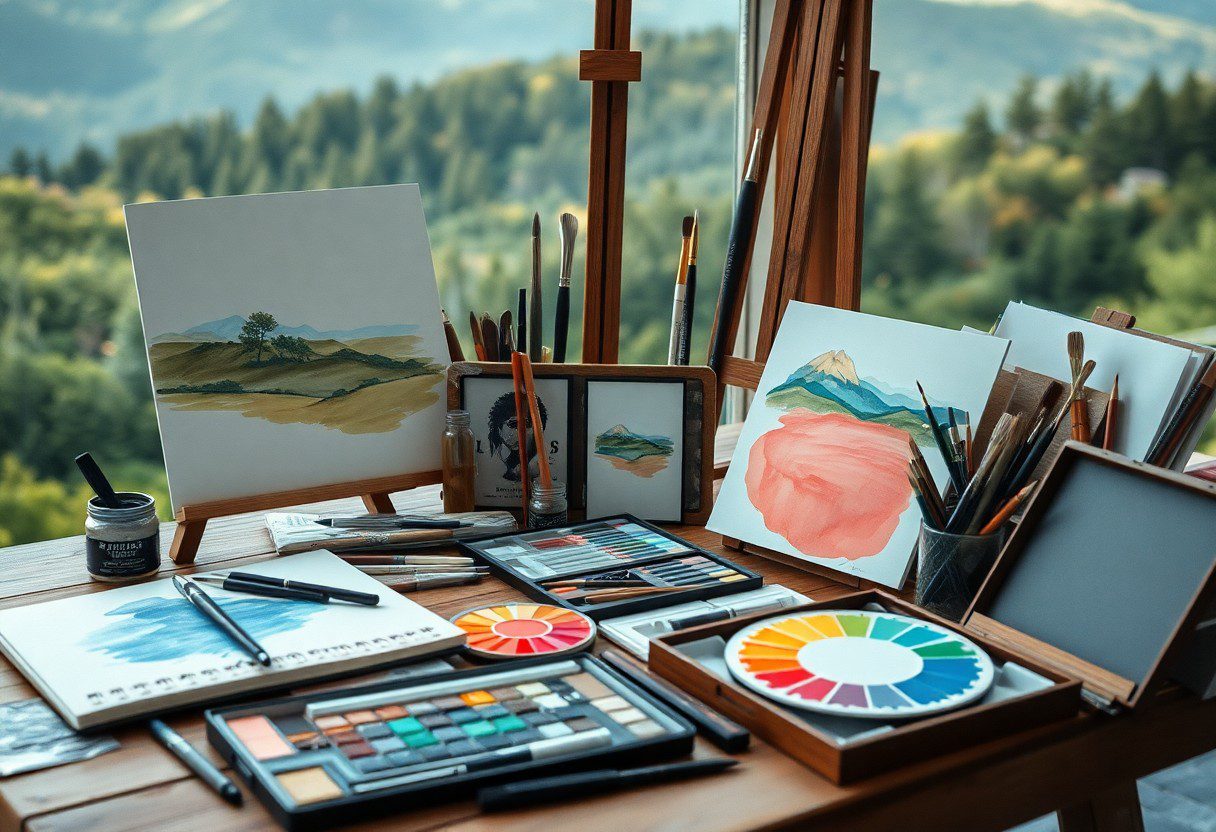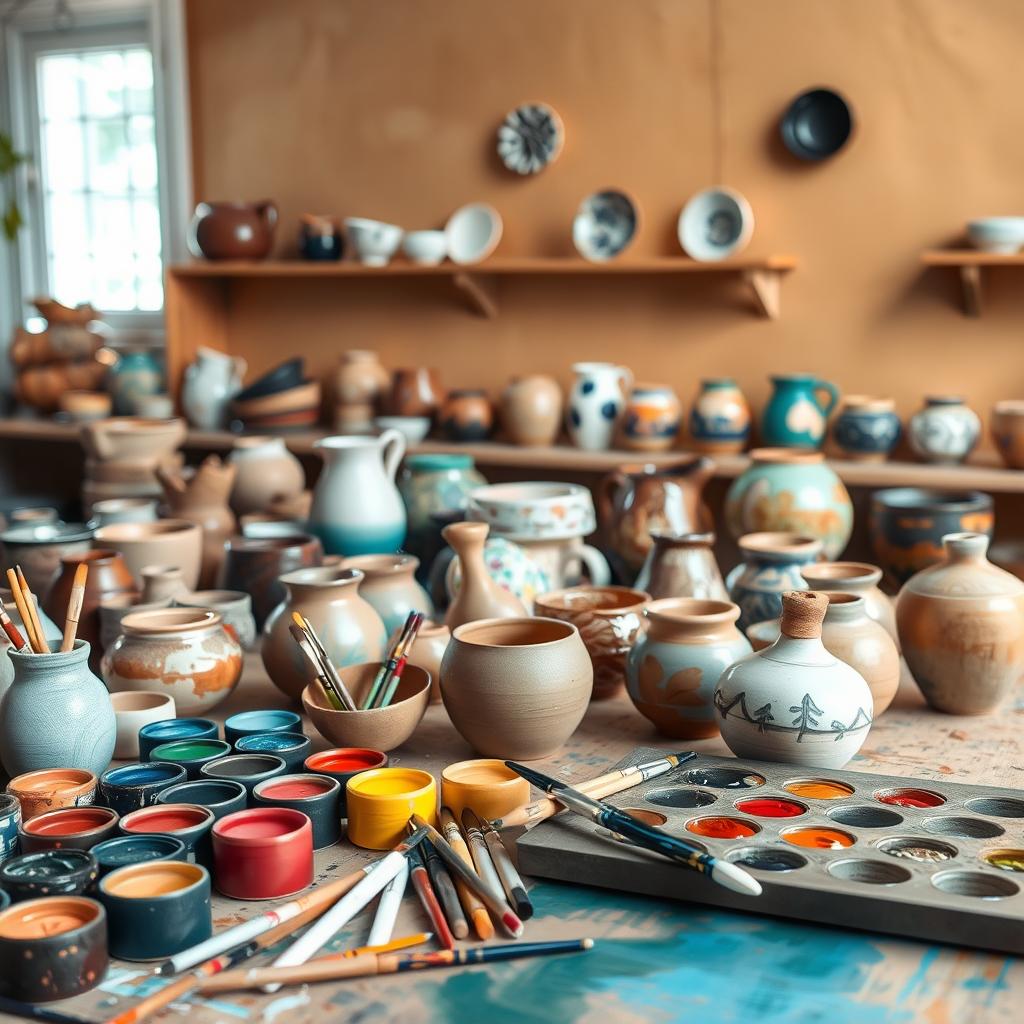Landscape artists often find themselves deeply inspired by nature’s beauty, but the right tools can make all the difference in translating that inspiration onto canvas. Whether you’re capturing serene meadows or rugged mountains, having the necessary supplies will enhance your creative expression and help you achieve your artistic vision. In this list, you’ll discover the top 10 must-have supplies that will empower you to create stunning landscape artwork and elevate your skills as an artist.
Sketchbook
While creating art outdoors, a sketchbook serves as your portable canvas, allowing you to capture fleeting moments and breathtaking landscapes in real-time. It’s your personal space to explore ideas and refine your artistic voice. Whether you’re working on a detailed study or a quick impression, having a sketchbook handy will make it easier to document those unique scenes that inspire you throughout your artistic journey.
Portable size
On your journey to becoming an accomplished landscape artist, a sketchbook with a portable size is important. It allows you to easily tuck it into your bag, enabling you to draw whenever inspiration strikes, whether you’re in a park, forest, or beach. The right size ensures that you can carry your artistic toolkit without feeling burdened.
Quality paper
With a sketchbook, you don’t want to compromise on quality paper, as it significantly affects your drawing experience and results. Quality paper can enhance the fluidity of your mediums—whether you’re using pencil, ink, or watercolor—allowing for smooth application and vibrant colors.
You can choose sketchbooks with different paper weights and textures that cater to your preferred style. Heavier, textured papers are ideal for wet mediums, while lighter papers suit dry mediums like graphite or charcoal. Investing in quality paper will ensure your sketches stand the test of time and look as vibrant years later as they did on the day you created them.
Pencils
Some of the most versatile tools in your landscape art kit are pencils. They allow for intricate detail work and precise lines, ideal for sketching out your composition or adding texture to your drawings. With a variety of hardness levels, pencils enable you to create everything from soft shading to sharp detailing, making them an necessary supply for any landscape artist.
Range of hardness
Assuming you choose to explore different pencil hardiness, you’ll find that they are graded on a scale from H (hard) to B (black) and F (fine point). Hard pencils (H) create lighter, crisp lines, while softer pencils (B) produce darker, richer strokes. This range lets you effectively convey depth and texture in your landscapes, adapting your tools to the specific requirements of each piece you create.
Graphite options
With a variety of graphite options available, you can select the right pencil for your artistic needs. You may find wooden pencils, mechanical pencils, and even specialty graphite sticks in your toolset. Each option offers unique advantages, from the convenience of mechanical pencils to the traditional feel of wooden ones, allowing you to choose what feels most comfortable for your style.
Options like wooden pencils offer a traditional approach with the ability to sharpen to a fine point, while mechanical pencils provide consistent line widths without the need for sharpening. Specialty graphite sticks, on the other hand, are perfect for larger areas or softer shading. By mixing and matching these options, you can enhance your creative process and achieve the desired effect in your landscape work.
Erasers
Assuming you want to create polished, professional-looking landscape art, a good eraser is important. Erasers not only help you correct mistakes but can also be used to create highlights and textures in your artwork. Choosing the right type of eraser will significantly enhance your drawing experience and results.
Kneaded eraser
Little known to beginners, the kneaded eraser is an incredibly versatile tool. Its malleable nature allows you to shape it into any form, making it ideal for lifting graphite or charcoal without disturbing your underlying work.
Precision eraser
On the other hand, the precision eraser offers you a sharp, defined tool perfect for removing fine lines and small details in your artwork.
Plus, its pointed tip can easily erase intricate sections, allowing you to maintain the integrity of your landscape with accuracy. This type of eraser is particularly beneficial for those delicate areas that require precision, ensuring your overall composition remains clean and professional. Whether you’re working on fine details or larger areas, having a precision eraser in your toolkit will elevate your artistic capabilities.
Blending Tools
Now that you have your colors ready, blending tools come into play to create smooth transitions and gradients in your landscape art. These tools allow you to merge different hues seamlessly, enhancing the depth and realism of your work. Whether you prefer to achieve a soft finish or a more textured effect, blending tools are necessary for fine-tuning your artwork. Make sure to choose tools that suit your medium to achieve the best results.
Stumps
On your journey to master landscape art, stumps are excellent blending tools that help you create soft edges and subtle transitions between colors. Typically made from tightly rolled paper, stumps allow you to manipulate charcoal, pastels, and pencils easily. You can utilize the pointed end for detailed blending and the wider end for larger areas, making them versatile for various landscape elements.
Tortillons
Some artists prefer tortillons for their finer blending capabilities. Tortillons are similar to stumps, but they are tighter and tapered at one end, which gives you more control, particularly in tighter spaces. They work especially well with softer mediums like charcoal and graphite, allowing for smooth application and gradient effects in your landscape scenes.
Plus, tortillons come in different sizes, enabling you to choose one that best fits your blending needs. They are perfect for creating intricate details in your landscape, like blending the fine lines of distant trees or softening the edges of a sunset. Their ability to create delicate and smooth transitions makes them a must-have tool for any serious landscape artist, ensuring your artwork captures the natural beauty and complexity of the scenery.
Watercolors
Despite being a versatile medium often associated with light washes and delicate blending, watercolors offer landscape artists a unique way to portray vibrant scenes with stunning depth. The fluidity of this medium allows you to capture the essence of nature, with colors that can radiate or recede depending on your technique. Mastering watercolors can enhance your landscape repertoire, making it an vital item in your supply kit.
Pan Sets
On the go? Pan sets are an excellent solution for landscape artists who need portability without sacrificing quality. These compact palettes come with pre-filled color blocks, allowing you to easily mix and match shades as needed. Their design makes organization a breeze, enabling you to focus more on your artistry rather than your supplies.
Watercolor Pencils
While traditional watercolors offer fluid application, watercolor pencils provide a unique blend of precision and versatility. You can create detailed lines and rich textures with the pencil itself, and by adding water, transform your sketches into beautiful washes. This dual functionality allows you to experiment with both sharp and soft edges in your landscape paintings, giving you greater flexibility in your artistic expression.
You can use watercolor pencils directly on the paper for controlled drawings, or blend colors seamlessly by washing over them with a wet brush. They enable you to build layers and textures that add complexity to your landscapes. Furthermore, these pencils are ideal for fieldwork, allowing you to sketch your surroundings and then easily enhance your work at home or in the studio by activating the colors with water.
Brushes
All landscape artists know that brushes are imperative tools that greatly influence the painting technique and outcome. Investing in a quality set of brushes allows you to achieve various textures, strokes, and details in your artwork. Choosing the right brushes enhances your ability to capture the beauty of nature and convey your artistic vision effectively.
Variety of shapes
With a diverse range of brush shapes available, you can unlock your creative potential. Flat, round, filbert, and fan-shaped brushes each serve distinct purposes, allowing you to create different effects, from broad washes to fine details. Selecting the appropriate shape for your needs can greatly impact your workflow and the overall look of your landscape paintings.
Different sizes
Variety in size is just as important as the shape of your brushes. You should strategically use smaller brushes for precise details while opting for larger ones for expansive areas. A well-rounded collection of sizes enables you to tackle any landscape element, be it delicate flowers or vast skies, providing the flexibility to express your artistic vision effectively.
Shapes, combined with sizes, allow you to achieve a range of effects in your artwork. Larger brushes can apply broad strokes to represent vast skies or fields, while smaller ones will help you refine intricate details like leaves and branches. By understanding the interplay between sizes and shapes, you’ll elevate your landscape artistry and create compelling visual narratives in your paintings.
Palette
Not every palette is created equal; selecting the right one can significantly enhance your landscape painting experience. A well-designed palette allows for better organization of your colors, promoting a more efficient workflow and allowing your creativity to flow unimpeded. Consider options that provide both flexibility and stability as you mix and apply your paints outdoors.
For Color Mixing
You need a palette that provides an ample mixing space to help you achieve the perfect hues for your landscape scenes. Look for palettes that offer both a large surface area and compartments to separate your colors, allowing for seamless transitions and blending. This will ensure you can easily customize your palette to suit the specific nuances of the landscape you are capturing.
Easy to Clean
Some palettes can be a hassle to clean, making your painting process tedious. Opt for palettes that are both durable and easy to maintain, saving you time and keeping your creative flow uninterrupted.
This choice will not only enhance your painting efficiency but also protect your investment in supplies. Materials such as plastic, glass, or disposable palettes can be quickly wiped down or rinsed off, allowing you to shift your focus back to your artwork rather than the cleanup process. A palette that stands up to quick washes or doesn’t cling to dried paint can make a significant difference in your overall painting experience.
Markers
To elevate your landscape artwork, including a variety of markers in your supplies will allow you to experiment with bold colors and fine details. Markers are versatile tools that enable you to add intricate designs, vibrant hues, and unique effects to your pieces, making them an crucial addition to your artistic toolkit.
Alcohol-based
With alcohol-based markers, you benefit from rich colors and quick-drying properties, making them ideal for layering and blending. Their smooth application can create impressive gradients, perfect for capturing the delicate nuances of landscape features.
Fine tip
There’s an undeniable advantage to using fine tip markers when working on detailed sections of your landscape art. These markers enable you to draw fine lines with precision, allowing you to depict intricate details such as tree branches, leaves, and grass blades effectively.
Fine tip markers enhance your ability to create realistic textures and details, enabling you to capture the essence of your subject matter. Their precision allows for controlled application, giving you the power to define shapes and outlines in your artwork. When you incorporate fine tip markers into your landscape projects, you’ll find it easier to achieve the depth and dimension that bring your scenes to life.
Reference Materials
After establishing your palette and gathering your tools, it’s important to have reference materials on hand. These resources will serve as guides, helping you capture the essence of landscapes accurately. Whether it’s photographs, color swatches, or sketches, reference materials enhance your understanding and interpretation of the natural world, allowing you to infuse authenticity and creativity into your artwork.
Nature Photographs
Some landscape artists find nature photographs invaluable for capturing details and atmosphere. These images enable you to study light, shadow, and color variations that occur in nature. By analyzing photographs, you can replicate the intricate features of landscapes, ensuring your artwork resonates with the beauty and complexity of the environment you’re depicting.
Color Swatches
On your artistic journey, color swatches can play a significant role in guiding your color choices. These samples help you develop a cohesive color palette, ensuring that your artwork reflects the harmonious hues found in nature. By referring to swatches, you can effectively capture the essence of specific landscapes, providing depth and vibrancy to your compositions.
Any artist knows that color is a powerful element in conveying emotion and atmosphere. By organizing your color swatches, you can experiment and compare different hues that evoke the feelings you aim to express in your landscapes. Whether it’s the warm glow of a sunset or the cool tones of a misty forest, having a well-curated selection of swatches can enhance your color mixing process and ensure your paintings are vibrant and authentic.
Conclusion
To wrap up, equipping yourself with the top 10 must-have supplies for landscape artists will enhance your creativity and efficiency. Ensuring you have the right tools—like quality paints, brushes, and sketchbooks—will empower you to capture the beauty of nature with confidence. By investing in these necessary supplies, you set yourself up for successful and inspiring artwork, ultimately helping you develop your unique style and approach in landscape painting. Keep exploring and experimenting with your supplies to elevate your artistic journey.
FAQ
Q: What are the necessary supplies for landscape artists?
A: The necessary supplies for landscape artists typically include high-quality sketchbooks, a set of pencils or graphite sticks, watercolors or oil paints, brushes of various sizes, a palette for mixing, easels, masking tape, a portable water container, and a sturdy bag or case to carry all materials. These items help artists create detailed and vibrant landscapes.
Q: How do I choose the right sketchbook for landscape drawing?
A: When selecting a sketchbook for landscape drawing, consider the paper quality and weight. Look for thicker paper that can handle wet media if you plan to use watercolors. The size of the sketchbook should also match your preferred drawing style – larger sizes for detailed work and smaller sizes for portability. Additionally, bound sketchbooks are convenient, while loose sheets might offer flexibility.
Q: What type of paints should landscape artists use?
A: Landscape artists often choose between watercolors, acrylics, and oils. Watercolors are excellent for capturing soft colors and fluid textures, while acrylics offer vibrancy and quick drying times. Oil paints provide depth and richness but take longer to dry. The choice depends on the artist’s style, subject matter, and preferred painting techniques.
Q: Are there specific brushes needed for painting landscapes?
A: Yes, landscape artists typically use a variety of brushes to achieve different effects. Flat brushes are great for broad strokes and washes, while round brushes allow for fine details and textures. Fan brushes are useful for creating foliage or grass textures. Sable or synthetic bristle brushes can both work well, depending on the artist’s preference.
Q: What is the importance of a portable water container for landscape artists?
A: A portable water container is necessary for artists working with wet media, as it provides easy access to water for cleaning brushes and diluting paint while on location. Look for containers that are lightweight, spill-resistant, and easy to carry. Many artists prefer collapsible cups or squeeze bottles that can be sealed after use to prevent spills during travels.





